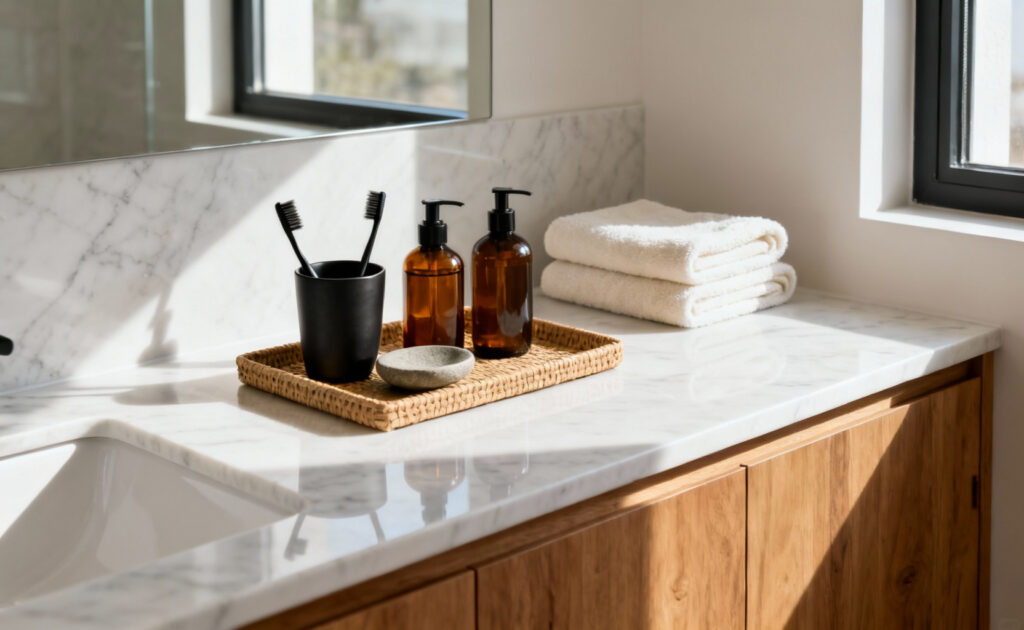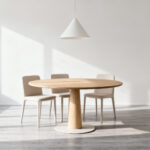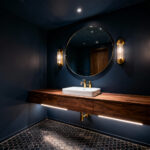We often treat the bathroom as a purely utilitarian station—a clinical backdrop for the morning rush and evening hygiene. Yet, from the perspective of wellness architecture, this room represents the final frontier of privacy in the modern home. It is the single space where social obligations vanish, offering a rare opportunity for a psychological reset and authentic self-revelation.
When we lock the door, we aren’t just isolating ourselves for privacy. We are creating a boundary that allows the mind to wander, brainstorm, and release the stress of external stimuli.
Historically, water served as a medium for spiritual transformation and purification. Today, that concept has evolved into private rituals for mental renewal. However, to fully realize this potential, the environment must transcend cold porcelain and tile to actively engage the senses. The transition from a sterile space to a private day spa relies heavily on the deliberate curation of tactile and visual elements. It is about moving away from efficiency and toward an atmosphere that invites you to linger, replacing clinical harshness with warmth, texture, and silence.
The difference between a standard washroom and a restorative sanctuary often lies in the sensory details. Strategic decor choices act as the physical tools that bridge the gap between function and feeling. From the grounding touch of brushed brass and heated stone to the mood-regulating power of layered lighting and aromatic diffusers, every element should serve a holistic purpose.
This guide explores curated sophisticated bathroom decor upgrades that elevate the ordinary into the extraordinary, helping you design a space that supports deep relaxation and daily restoration. These carefully considered bathroom accessories ideas focus on designing a space that supports deep relaxation and daily restoration.
Philosophy: Why accessorizing is not about decoration, but about regulating the nervous system
We often dismiss bathroom accessories as mere “finishing touches.” Yet, in the realm of wellness architecture, they serve a far more critical function: they act as external regulators for the autonomic nervous system.
When we view a chaotic countertop, our brains do not simply see a mess; they register unfinished business. This visual clutter acts as a constant stimulus, creating a low-grade chronic stress response that spikes cortisol and keeps us in a state of alert. By corralling loose items onto a dedicated tray or decanting liquids into uniform vessels, we are not just tidying; we are drastically reducing cognitive load. This visual order acts as a passive calming agent, allowing the mind to shift into the restorative “rest and digest” mode.
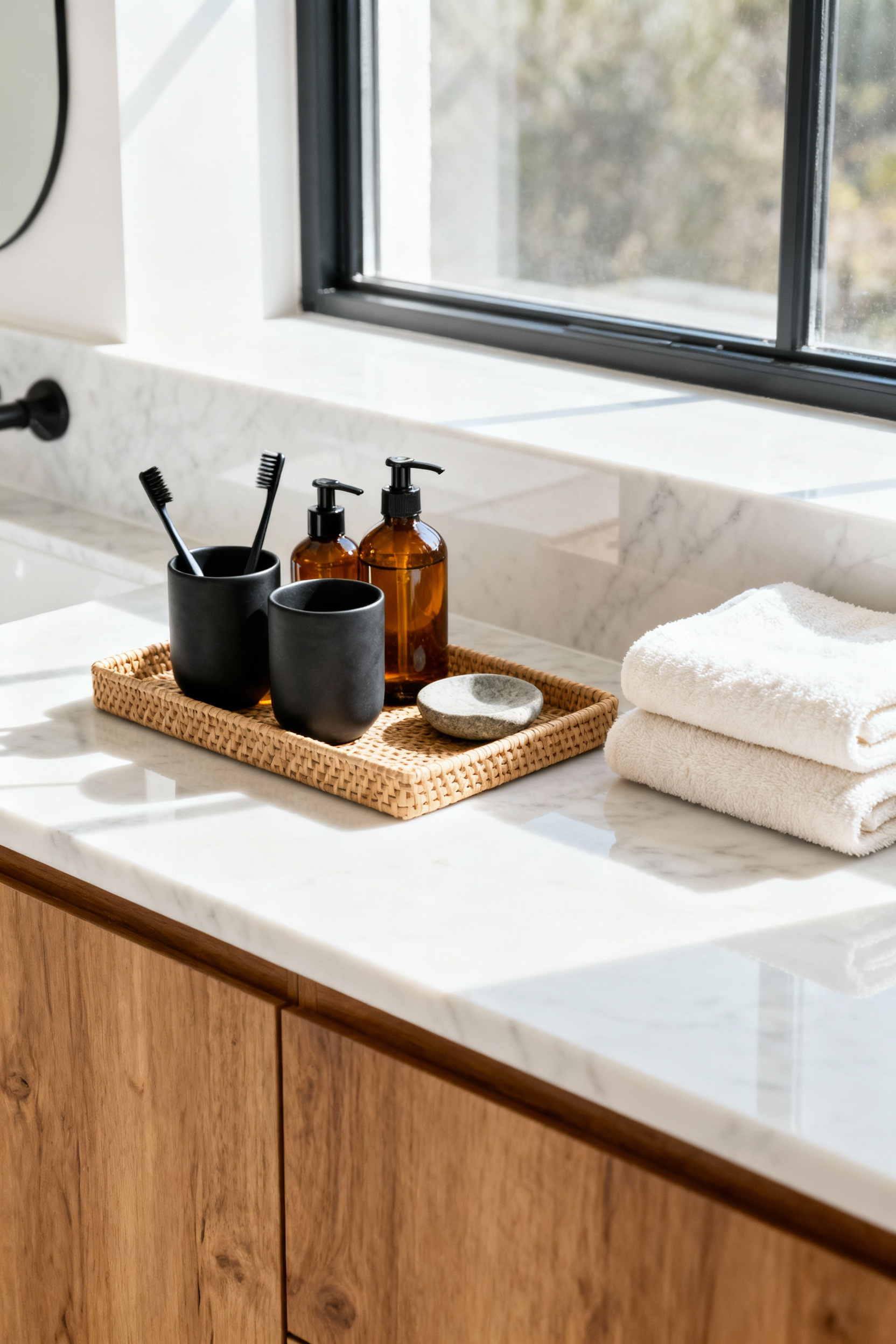
Beyond the visual, these objects offer essential haptic feedback that helps regulate emotional arousal. There is a profound difference between the flimsy touch of disposable packaging and the grounding weight of a stone soap dispenser. This is somatic grounding in practice.
The texture and density of our accessories provide proprioceptive input—a physical anchor that connects us to the present moment. When we engage with materials like heavy ceramics, natural wood, or dense textiles, we essentially invite our vagus nerve to process a signal of safety and stability.
Ultimately, these curated items transform mundane hygiene tasks into stabilizing rituals. A carefully chosen canister or a specific bamboo bath caddy stops being just an object and becomes a cue for the brain to enter a zone of safety and connection. In this light, accessorizing isn’t just about decoration; it is about constructing a sanctuary that actively nurtures your psychological resilience.
Section 1: Tactile Grounding (The Psychology of Touch)
Touch is often the forgotten element of interior design, yet it acts as a primary switch for our autonomic nervous system. When stress levels rise, our skin seeks distinct textures to anchor us back to reality, a process known as tactile grounding.
In the bathroom—a space often dominated by cold, slick surfaces—we can intentionally introduce haptic triggers to restore emotional regulation. Engagements with specific textures, such as the friction of a raw linen towel or the sturdy grip of a stone vessel, stimulate specialized nerve endings that respond to slow, deliberate contact, signaling a sense of safety to the brain.
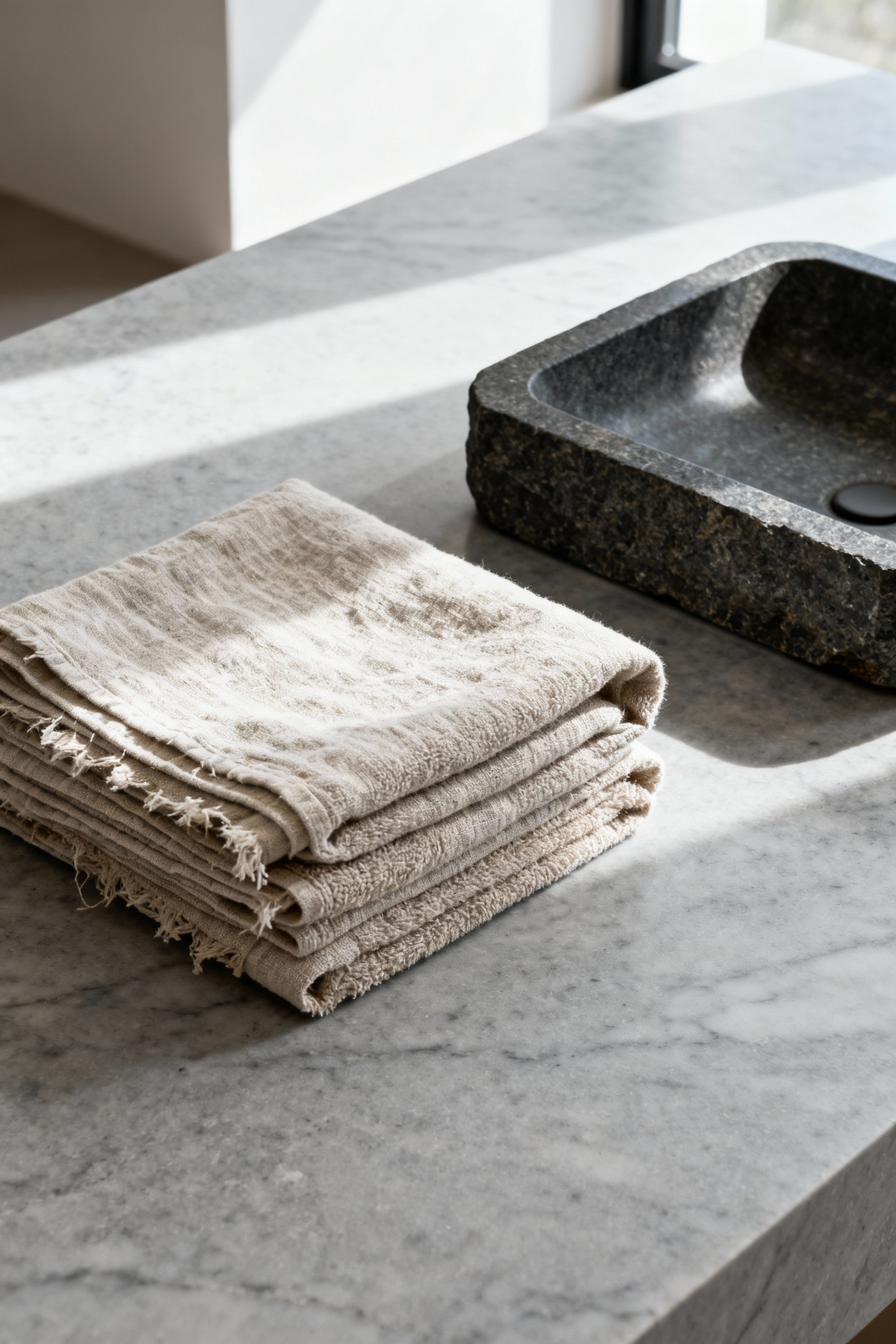
To maximize this grounding effect, look to biophilic materials. There is a primitive, psychological pull toward natural elements like unpolished stone, cedar, or hand-thrown ceramics. The experience of gripping a heavy, textured soap dispenser engages the full hand, offering physical stability that lightweight synthetics cannot match. Unlike the emotional flatness of mass-produced plastic, these organic materials age gently and hold warmth, transforming a routine wash into a moment of genuine connection.
Achieving a truly restorative atmosphere requires balancing these heavy, grounding elements with softness. Since the architecture of a bathroom relies on hard porcelain and glass, we must counterbalance with tactile layering. Plush cotton mats or matte-finished metal fixtures absorb light and invite touch, avoiding the visual overstimulation of high-gloss chrome. Even the smallest details contribute to this equilibrium; luxury fixtures featuring ceramic or stone inlays on control knobs create a satisfying, tactile bridge between the user and the water, ensuring that every interaction reinforces a state of calm.
1. Organic Waffle-Weave Towels: Choosing textures that stimulate circulation without irritation
When designing for wellness, we often overlook the tactile mechanics of drying off. While standard plush terry cloth simply pushes moisture around, an organic waffle-weave towel creates a functional shift in your daily routine. Its distinct honeycomb structure—a landscape of raised ridges and recessed pockets—provides gentle friction against the skin. This texture delivers a daily micro-massage that stimulates blood flow and lightly exfoliates the body, leaving the skin feeling reinvigorated rather than just dry.
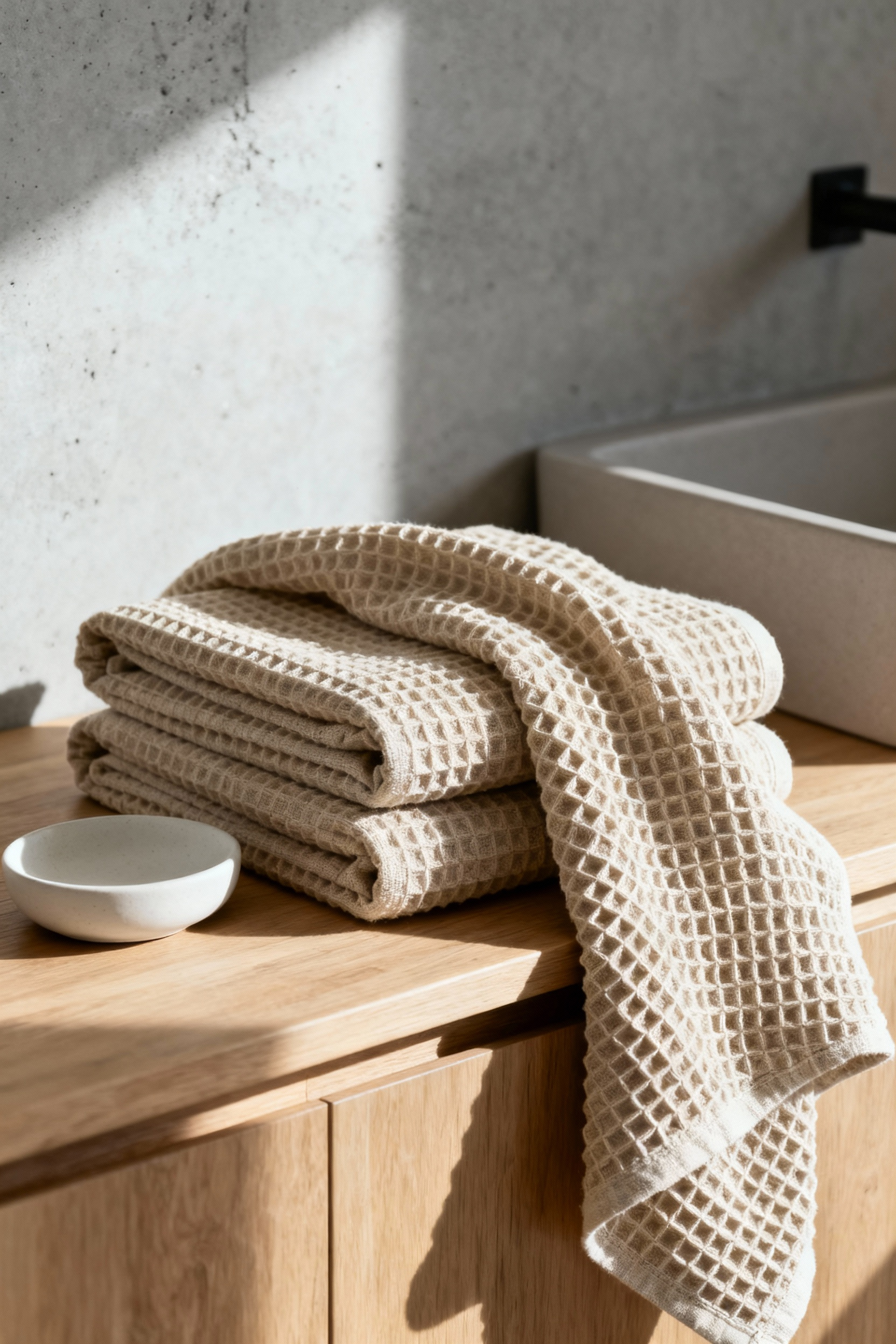
This sensation of “invigoration” must be balanced with purity to prevent irritation. Sourcing GOTS-certified organic cotton is essential here, as it ensures the fiber is free from pesticide residues and harsh synthetic dyes that often trigger sensitivities. This chemical purity is matched by the weave’s biological advantages; the open, breathable grid allows the fabric to dry rapidly. By reducing the time moisture is trapped within the fibers, these towels naturally inhibit the growth of mildew and bacteria, addressing a common source of skin irritation found in denser, slower-drying textiles.
Embracing this texture connects your bathroom to the restorative traditions of Japanese *Onsen* culture, where the emphasis is on lightweight, breathable tools. By switching to organic waffle-weave, you are choosing a towel that feels lighter and cleaner, effectively blending the science of skin health with the aesthetic of functional minimalism.
2. Diatomaceous Earth Bath Mats: The science of instant-dry, antimicrobial surfaces
At the intersection of geology and home hygiene lies Diatomaceous Earth (DE), a material that fundamentally changes how we interact with water in the bathroom. While it resembles a simple stone slab, a DE mat is actually composed of the fossilized remains of diatoms—single-celled algae with cell walls made of amorphous silica. This unique composition creates a structure that is roughly 90 percent porous. Think of it as a rigid, microscopic honeycomb; when you step out of the shower, millions of interconnected micropores immediately draw water away from your feet through powerful capillary action.
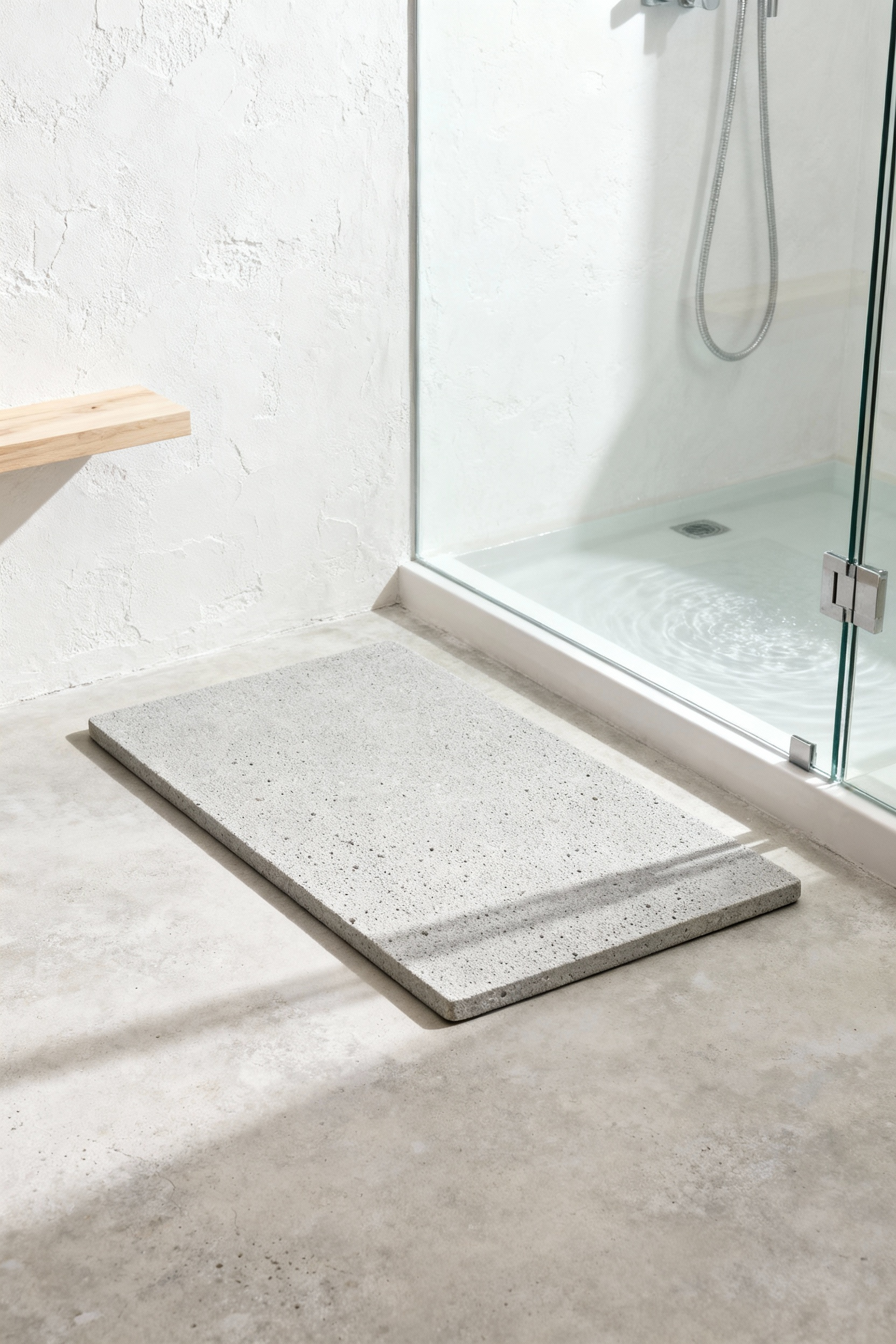
The result is a surface that feels dry almost instantly, eliminating the unpleasant, soggy sensation of traditional textiles. But the benefits extend beyond tactile comfort into legitimate wellness. Because the water is rapidly absorbed and then released back into the air through evaporation, the mat dries completely within minutes.
This rapid cycle effectively “starves” mold, mildew, and odor-causing bacteria, which require persistent dampness to colonize and multiply. Instead of relying on chemical treatments, the mat uses physical desiccation to maintain a naturally antimicrobial environment.
This application of fossilized earth is a modern pivot for a material long trusted in water filtration and food storage. It brings a utilitarian elegance to bathroom design, often associated with Japanese minimalism—fitting, as early innovators in this space derived their names from the Japanese word for “dry.” By replacing moisture-retaining fabrics with these active mineral surfaces, we reduce the biological burden in the bathroom, ensuring the space supports your health rather than compromising it.
3. Weighted Silk Eye Masks: integrating sensory deprivation into the bathing ritual
True relaxation often requires more than just warm water; it demands the intentional shutting down of visual noise. A weighted silk eye mask serves as a sophisticated neurological anchor within the bathing ritual, transcending the function of a simple sleep aid. The mask’s gentle, distributed pressure—often provided by flax seeds or glass beads—initiates the Oculocardiac Reflex. This biological response stimulates the Vagus nerve, instantly lowering heart rate and signaling the body to shift from a “fight-or-flight” state into deep rest.
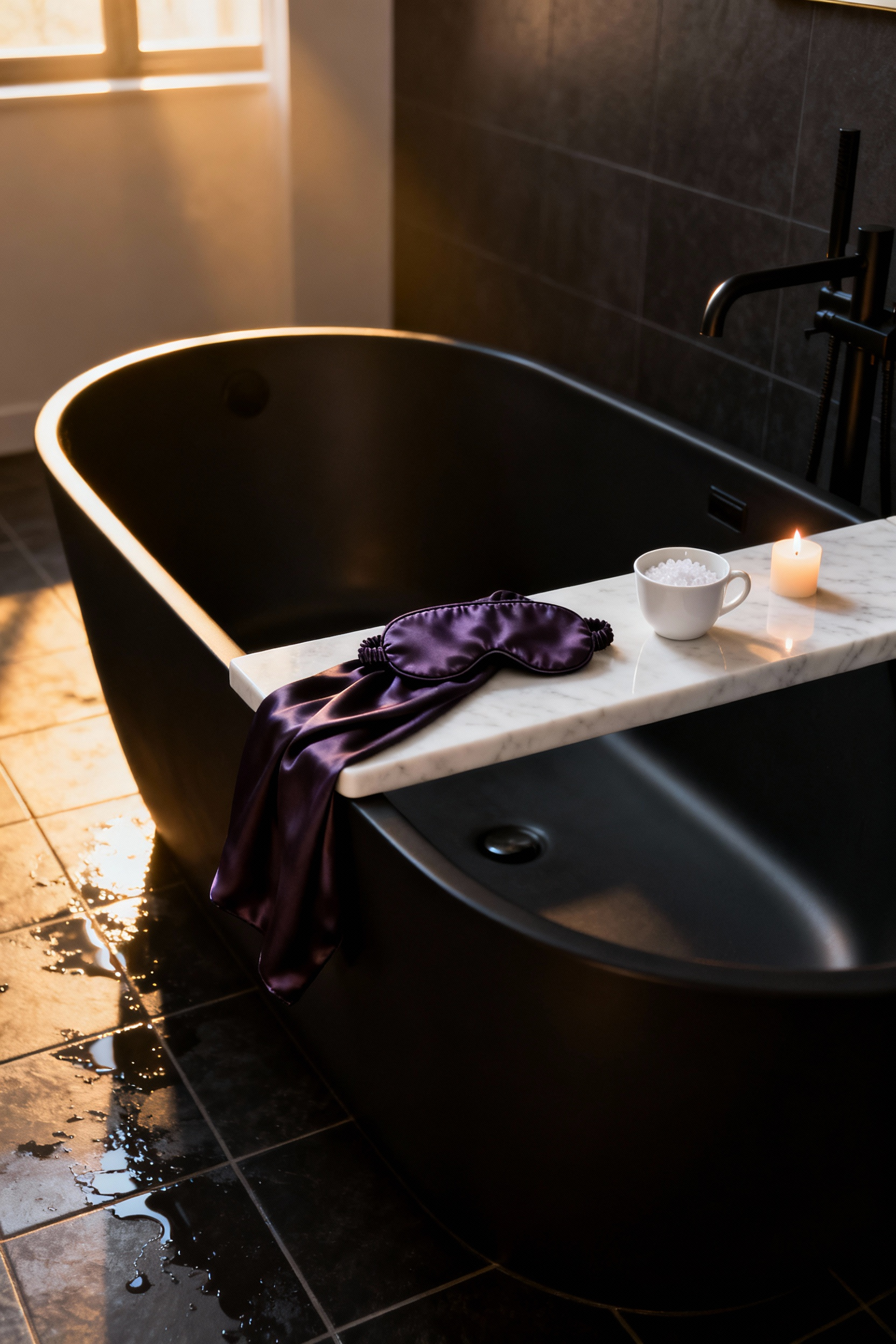
While the weight facilitates this internal shift, the choice of material dictates the external sensory experience. High-momme silk offers a frictionless, cooling surface that is essential for the delicate skin around the eyes, preventing the moisture absorption and friction common with cotton or synthetics. This material choice also allows for thermal versatility; the mask can be chilled to act as a cold compress, reducing puffiness and providing a crisp, grounding contrast to the enveloping steam of a hot bath.
Integrating this accessory mirrors the ancient Ayurvedic principle of protecting the eyes as a vital energy point, similar to the traditional practice of *Hastatalam* or eye palming. By imposing total darkness and gentle weight, you create a private sensory deprivation chamber. This turns the bathroom into a true sanctuary where external stimuli are paused, allowing for a profound moment of inner stillness.
4. The Teak Shower Bench: Bringing warmth and spa-level functional seating into wet zones
Teak isn’t just an aesthetic choice; it is a material with a formidable resume in resilience. Historically mandated by the British Navy for ship construction, this wood creates a bridge between maritime engineering and modern wellness design. Its durability comes from a naturally high concentration of oils and silica, which act as a self-preserving waterproofing system. This internal chemistry prevents the warping, cracking, and rot that plague other timbers, allowing the bench to withstand the high humidity of a shower as effortlessly as a ship deck withstands the ocean.
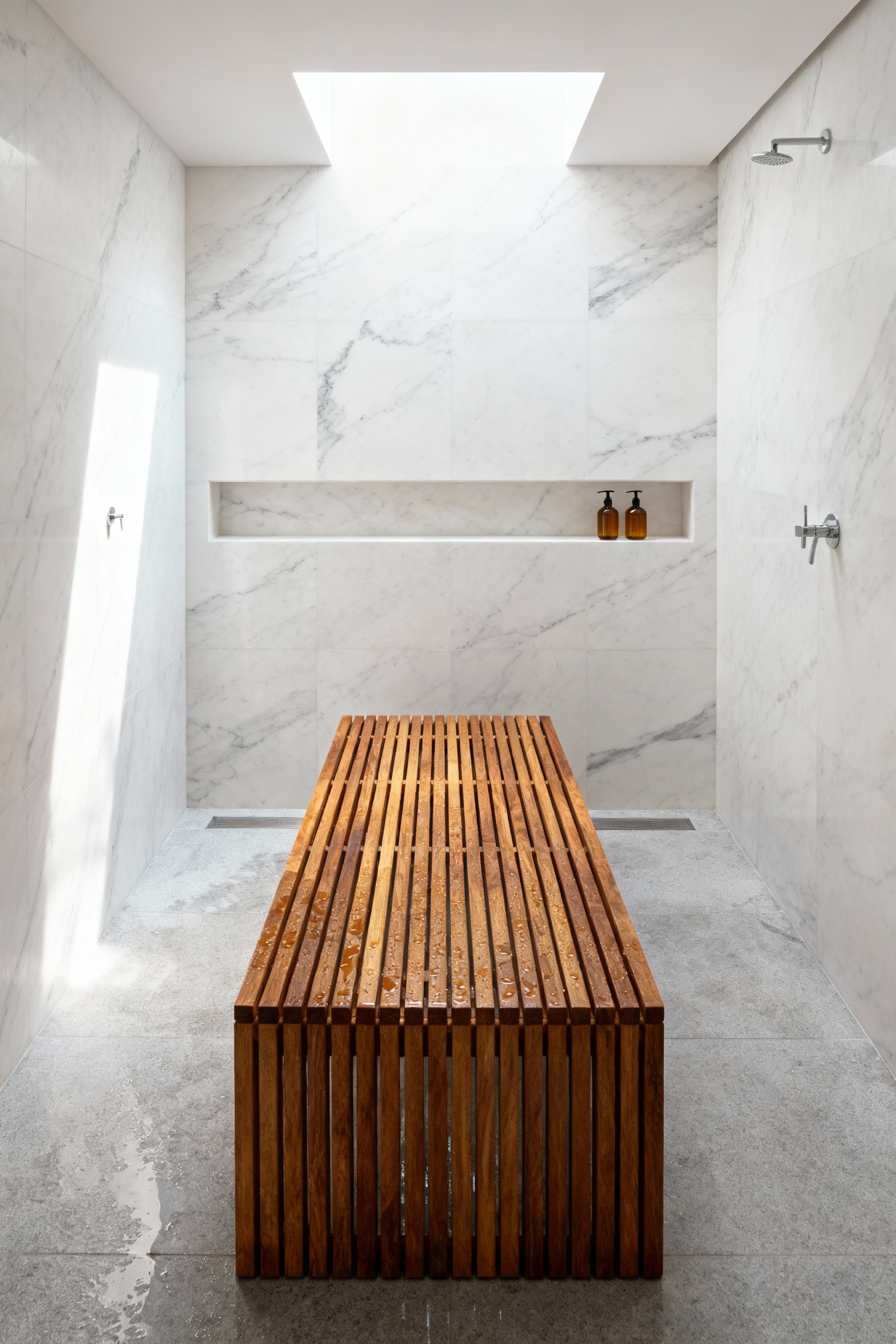
From a wellness perspective, bathrooms are frequently dominated by cold, hard surfaces like porcelain, chrome, and stone. Introducing teak disrupts this clinical atmosphere by adding a layer of organic warmth and texture—a concept we often refer to as a “natural harmonizer.” Unlike tile, which can feel shocking against the skin, wood regulates temperature effectively, offering a tactile seating surface that is neither too hot nor too cold. This transforms a standard grooming space into a sensory retreat, where you can sit comfortably to shave, exfoliate, or simply pause under the water. If you are looking for more inspiring bathroom decor ideas for a spa-like experience, read our full guide.
While the visual of fresh golden-brown wood is striking, untreated teak will eventually weather to a distinguished silvery-gray patina. This shouldn’t be viewed as deterioration, but rather as a graceful maturation of the material within its environment. However, because this is a precious natural resource, responsible sourcing is non-negotiable. To ensure your sanctuary supports planetary health, always verify that your furniture carries Forest Stewardship Council (FSC) certification, guaranteeing the wood was harvested from sustainably managed plantations rather than endangered old-growth forests.
Section 2: Biophilic Integration (Connecting to Nature)
Biophilic design transforms the bathroom from a sterile utility into a restorative sanctuary by engaging our innate need to connect with the natural world. This philosophy shifts the focus from simple hygiene to a ritual of renewal, grounded in the way our bodies respond to our environment.
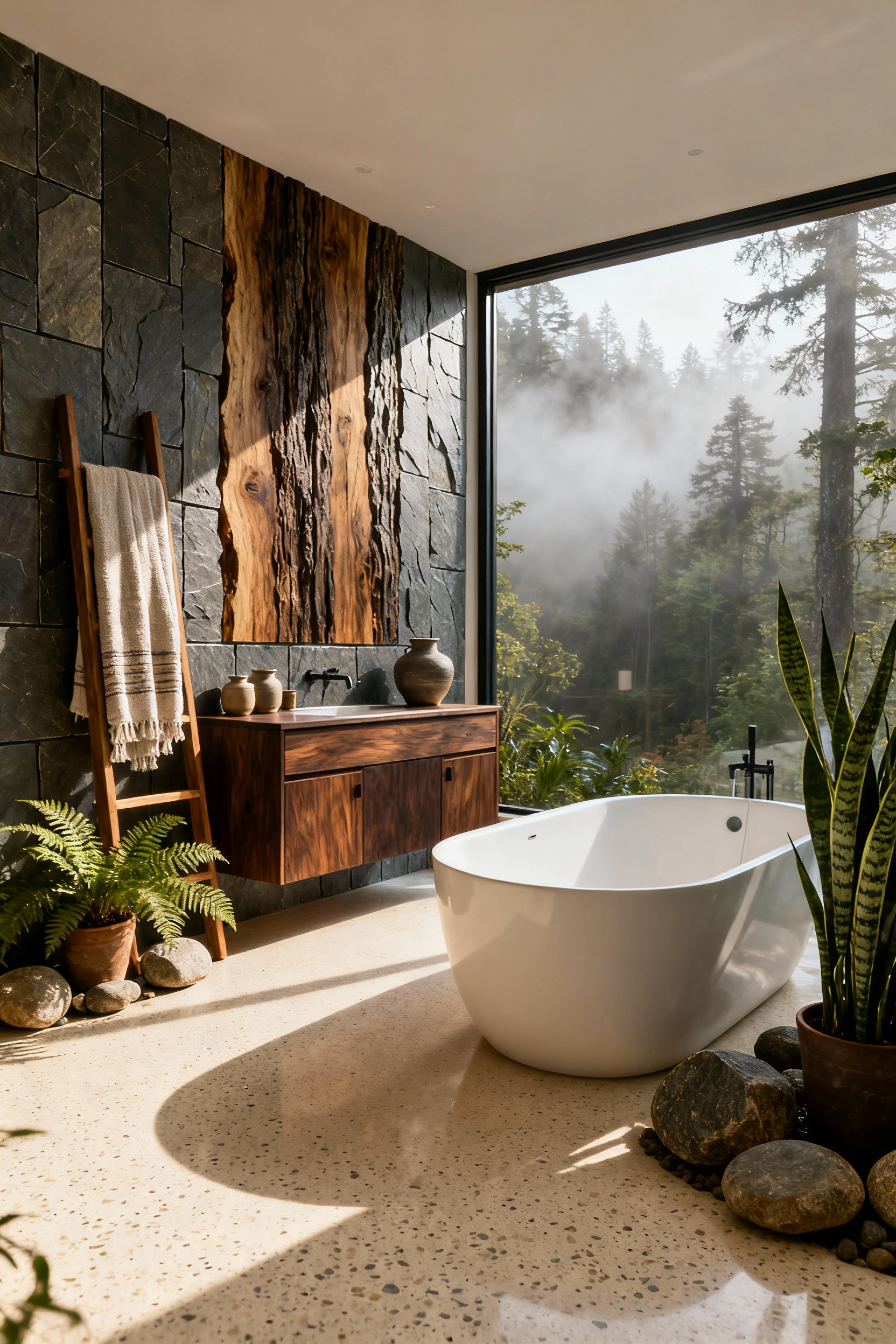
The most immediate impact comes from the haptic experience—how a space feels to the touch. Modern bathrooms are often dominated by cold, hard porcelain, so introducing tactile diversity is essential for reducing physical stress. Incorporating a teak shower bench or a woven seagrass hamper offers a crucial counterpoint; unlike synthetic surfaces, touching these warm, organic textures can actually lower skin temperature and blood pressure, providing a grounding sensory input that mimics a forest floor.
Beyond texture, a truly restorative space must consider sound. Historically, bathing was a meditative act, and we can reclaim that serenity by focusing on water as a soundscape. The goal is to mimic the calming “white noise” of nature to lower cortisol levels. While a rainfall showerhead envelops the body in a gentle, natural deluge, even a small tabletop fountain on a vanity can introduce the soothing rhythm of a babbling brook, instantly softening the room’s atmosphere.
Visually, this connection is strengthened through biomorphic forms and living elements. Swapping sharp, manufactured angles for the curved, irregular shapes of a river-stone soap dish or a driftwood-framed mirror reduces cognitive load. Finally, plants serve as dynamic, living accessories. Species like ferns or Pothos thrive in bathroom humidity, purifying the air and adding a vital, growing energy that static decor simply cannot replicate.
5. Humidity-Thriving Eucalyptus Bundles: Natural aromatherapy activated by steam
Transforming your daily rinse into a therapeutic ritual requires understanding the alchemy between heat and botany. When you suspend fresh eucalyptus in the bathroom, you aren’t just adding greenery; you are utilizing a passive essential oil diffuser. The native Australian plant contains 1,8-cineole, a compound stored in tiny oil glands on the leaves. As the shower heats up, the rising steam vaporizes these volatile oils, releasing a camphoraceous, minty aroma known to act as a natural expectorant and decongestant.
To maximize this effect, secure the bundle behind the showerhead or on a hook where steam accumulates, but keep it out of the direct stream of water to preserve the oils’ longevity. For a more immediate release, try gently rolling the leaves with a rolling pin before hanging them to break the surface oil sacs and prime the scent.
Beyond the respiratory benefits, this accessory serves a dual purpose in wellness architecture. Visually, the matte, silvery-green foliage of varieties like *Baby Blue* or *Silver Dollar* provides a softening, organic texture against the hard lines of porcelain and glass. Simultaneously, the scent signals the brain to lower anxiety and engage the parasympathetic nervous system. It is a design choice that looks like a spa-style upgrade but functions as a neurological reset, promoting clarity in the morning and deep relaxation at night.
6. Living Walls or Hanging Ferns: Air purification and the visual calm of greenery
In the stark landscape of porcelain, glass, and chrome, a bathroom can easily feel clinically sterile. Introducing greenery is a core tenet of Biophilic Design intended to soften these hard edges. By bringing organic textures indoors, we create a necessary visual disruption to the room’s non-porous surfaces. The delicate, chaotic fronds of a Maidenhair Fern or the cascading vines of a Pothos provide a psychological anchor, signaling your nervous system to lower cortisol levels. This visual calm effectively transforms a purely functional washroom into a restorative sanctuary.
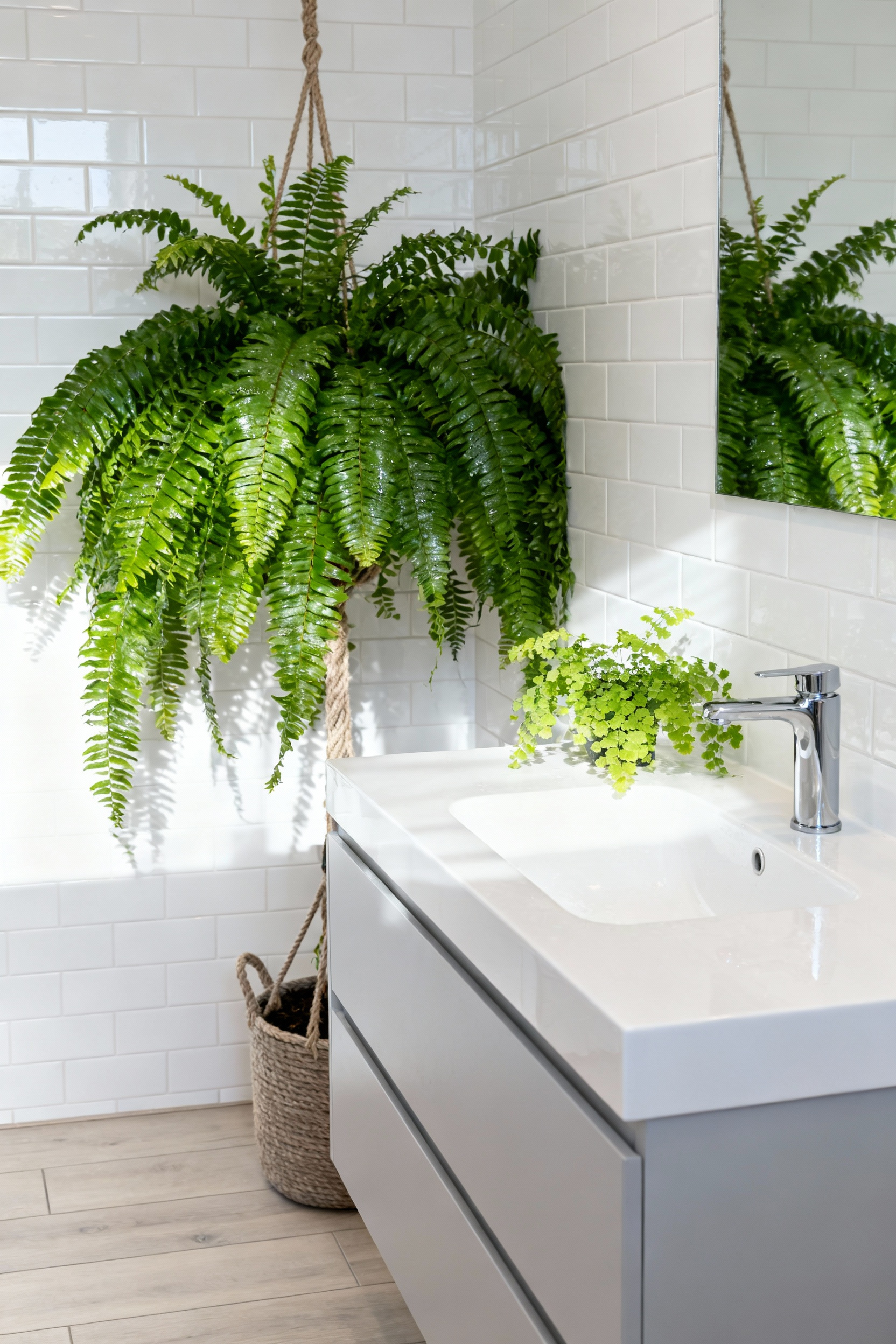
Beyond aesthetics, foliage plays a functional role in mitigating invisible pollutants. Bathrooms are notoriously prone to off-gassing Volatile Organic Compounds (VOCs) like formaldehyde, often found in adhesives and cleaning products. While a single potted Boston Fern offers passive filtration, the latest innovation in wellness architecture involves “active” living walls. These systems mechanically draw air through the root zone, using microbes to convert toxins into nutrients—a powerful biofiltration tool for superior indoor air quality.
However, installing a full living wall requires complex irrigation and lighting considerations to prevent moisture damage behind the panels. For a more accessible approach, utilize the bathroom’s natural humidity. Hanging species like Spider Plants or Bird’s Nest Ferns thrive in damp, low-light conditions with minimal intervention. If maintenance is a barrier, consider a preserved moss wall. It delivers the sound-dampening acoustic benefits and biophilic texture of a living wall without the need for water or sunlight, ensuring your space remains a source of relaxation rather than a chore.
7. Raw Travertine Trays: Utilizing natural stone to ground countertop clutter
Unfilled travertine carries a distinct sensory weight that offers more than just a place to organize toiletries. In the context of wellness architecture, we use this raw, chalky material to introduce the concept of “grounding.” Modern bathrooms are often filled with small, lightweight, and temporary items—plastic containers, glass vials, and synthetic tools.
Placing these disparate objects on a heavy, dense slab of raw stone acts as a visual anchor. The organic imperfection of the pitted surface—marked by voids and fissures formed by ancient hot springs—absorbs the visual noise of the clutter, offering a sense of stability that sleek, polished marble simply cannot replicate.

There is also a profound comfort in interacting with a material that boasts such a monumental legacy. As the foundational stone of the Roman Colosseum, travertine implies endurance. Bringing a piece of this geology into your home creates a narrative of longevity that contrasts beautifully with the consumable nature of cosmetics. Its soft, biscuit-toned palette brings an earthy warmth to the typically cool, sterile surfaces of a washroom, bridging the gap between rustic charm and quiet luxury.
However, embracing this organic beauty requires a mindful approach to care. Because raw travertine retains its natural porosity, it is highly susceptible to absorbing liquids and oils. To prevent deep staining or discoloration from bathroom moisture, these trays must be treated with a high-quality penetrating sealer annually. It is also vital to remember that as a calcium-based stone, travertine is sensitive to acidic skincare products which can etch the surface. Treating the accessory with this level of care reinforces the connection between you and your environment, ensuring the stone remains a permanent, calming fixture in your daily routine.
8. Bamboo Bathtub Caddies: Sustainable materials for the ‘unplugged’ soak
Transforming a simple bath into a restorative ritual requires the right architecture, and the bamboo bathtub caddy is the cornerstone of the “unplugged” soak. Unlike cold metal or sterile acrylic, bamboo introduces a tactile warmth and organic grain that immediately softens the hard surfaces of a bathroom, contributing to a serene, spa-like atmosphere essential for mental decompression.
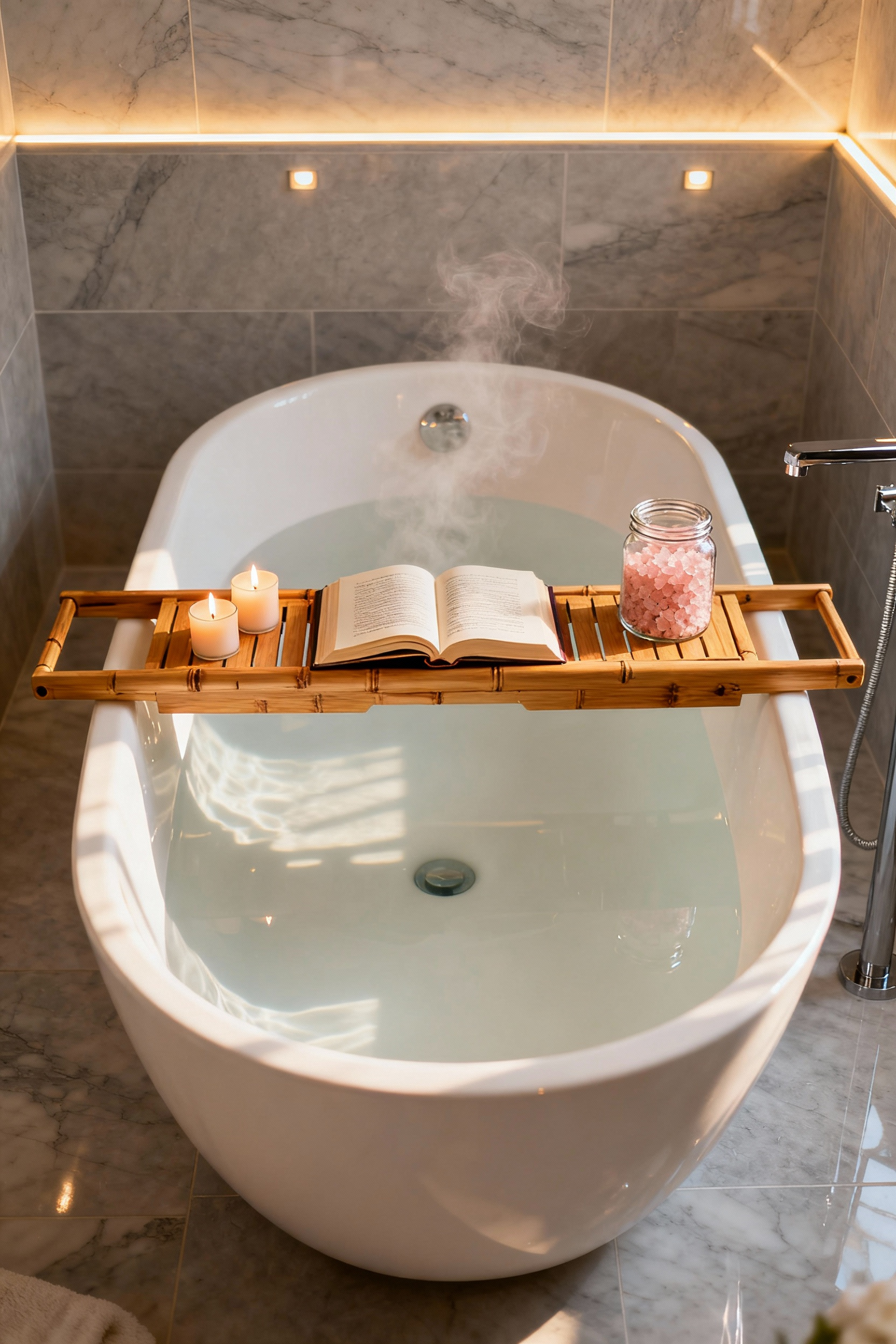
These accessories are engineered specifically to support mindfulness. By providing secure slots for a wine glass and an adjustable stand for a book or tablet, the design allows for a hands-free experience, letting you submerge fully without the anxiety of dropping your belongings. Even the inclusion of a phone slot serves a wellness purpose; it keeps technology safe from water damage while keeping it out of your direct line of sight, encouraging a true break from connectivity.
Beyond the immediate sensory benefits, choosing bamboo aligns your personal wellness with planetary health. As a grass capable of growing nearly three feet daily, bamboo regenerates rapidly without the destructive harvesting required for hardwoods. It is naturally antimicrobial—a massive benefit in humid environments—and possesses a strength-to-weight ratio that rivals steel. When selecting a caddy, ensure it features a high-quality non-toxic sealant. This protective layer is vital for preventing warping and mold, ensuring that your sustainable, biodegradable accessory remains a hygienic part of your self-care routine for years to come.
Section 3: Visual Silence (Mindful Organization)
Visual Silence is less about stark minimalism and more about neurological relief. When we stand at a bathroom counter crowded with varied bottles, bright commercial logos, and disparate shapes, our brains involuntarily process every bit of that visual data. This increases cognitive load and can actually elevate cortisol levels right when we need to be winding down or preparing for the day. By intentionally quieting the environment, we turn accessories into tools for psychological calm.
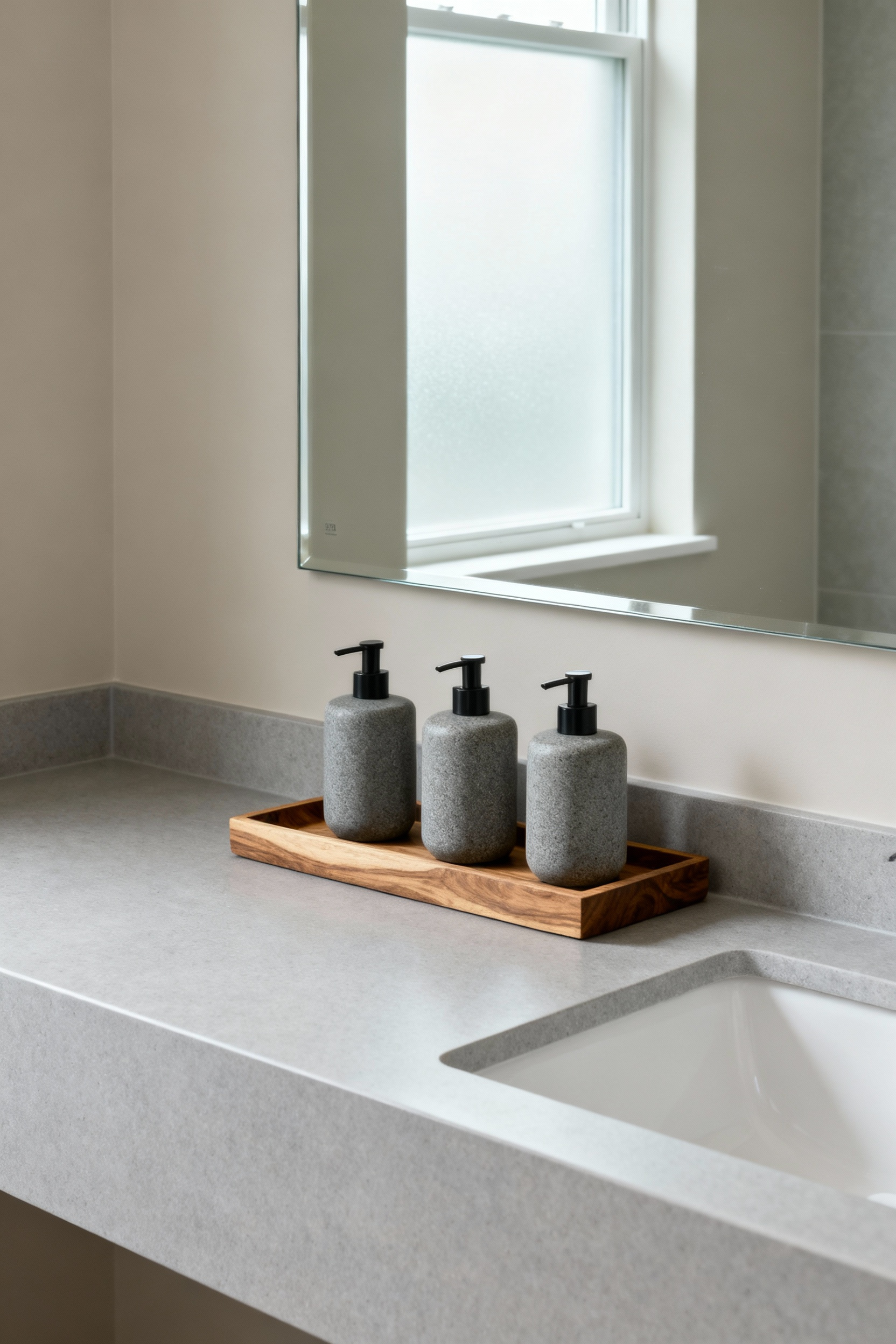
We can achieve this by borrowing from the Japanese concept of *Ma*, where empty space is treated with as much significance as the objects it holds. Instead of a cluttered surface, imagine a vanity featuring only a solitary, high-quality ceramic vessel or a small, unadorned tray. This negative space creates “breathing room” for the eye, framing the essentials and transforming a functional surface into a moment of pause.
To make this practical, we must eliminate “brand noise.” Commercial packaging usually shouts for attention with clashing colors and text. The ritual of decanting products into uniform vessels is transformative here. Pouring shampoos, soaps, and lotions into matching amber glass or matte ceramic dispensers allows ten distinct items to read visually as a single, coherent unit.
For the items that cannot be decanted, hidden organization is key. Functional clutter like cotton swabs or backups should live inside drawers, organized in opaque bins or fitted dividers. What remains visible should prioritize matte finishes and tactile materials like stone or wood, blending softly with the room’s architecture rather than competing for attention. This curation fosters a sense of presence, ensuring the bathroom serves as a true sanctuary for the mind.
9. Uniform Amber Glass Dispensers: Reducing ‘brand noise’ and visual cognitive load
There is a subtle form of low-grade stress lurking on many bathroom counters, often referred to as “brand noise.” Commercial packaging is designed to grab attention on a crowded supermarket shelf using high-saturation colors and discordant text. When brought into the home, however, this lineup creates unnecessary visual cognitive load. Your brain is forced to process these competing signals, which prevents the mind from truly relaxing.
By decanting products into uniform amber glass dispensers, you effectively silence this commercial clutter. For more simple bathroom decor ideas that prioritize minimalism, consider this approach. The result is an immediate sense of visual calm; the eye can glide over the countertop without snagging on mismatched labels, creating a “Zen effect” that allows the nervous system to rest.
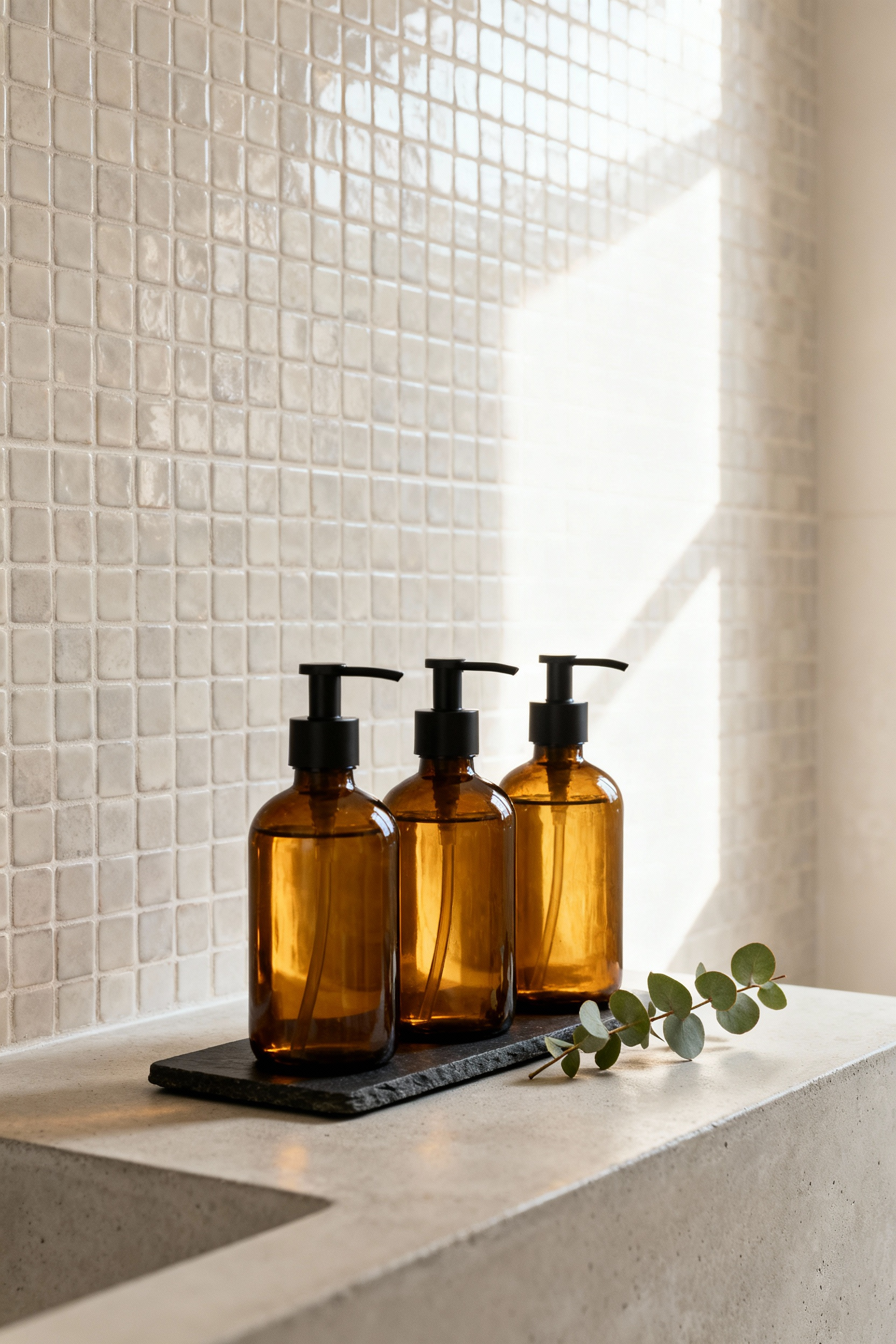
The specific choice of amber glass offers more than just organization; it introduces a narrative of heritage and warmth. Historically, chemists and apothecaries utilized brown glass to filter out harmful UV light, protecting the potency of light-sensitive medicines. Adopting this aesthetic in the home taps into that deep-seated association with healing, craft, and scientific trust, elevating a simple hand soap into something that feels like a curated, restorative tonic.
Furthermore, the deep, golden-brown hue of the glass serves a critical architectural function. Bathrooms are frequently dominated by “cold” materials—white porcelain, grey tile, and chrome fixtures. The amber glass provides a rich, warm counterpoint that softens the room’s sterility. This shift creates a sense of coziness and intimacy, transforming a strictly utilitarian washroom into an intentional sanctuary for self-care.
10. Concealed Waste Management: The importance of negative space in small rooms
In the intimate footprint of a small bathroom, the human brain unconsciously catalogues every visible object. A freestanding waste bin, regardless of its design pedigree, acts as a distinct visual distraction—an irregularity that competes for attention and interrupts the calm we seek in these spaces. By eliminating this unintegrated accessory, we create essential “visual breathing room.”
This negative space is not merely an absence of clutter; it is an active design feature that allows the mind to rest, contributing to a tangible reduction in cognitive load and a smoother transition into relaxation.
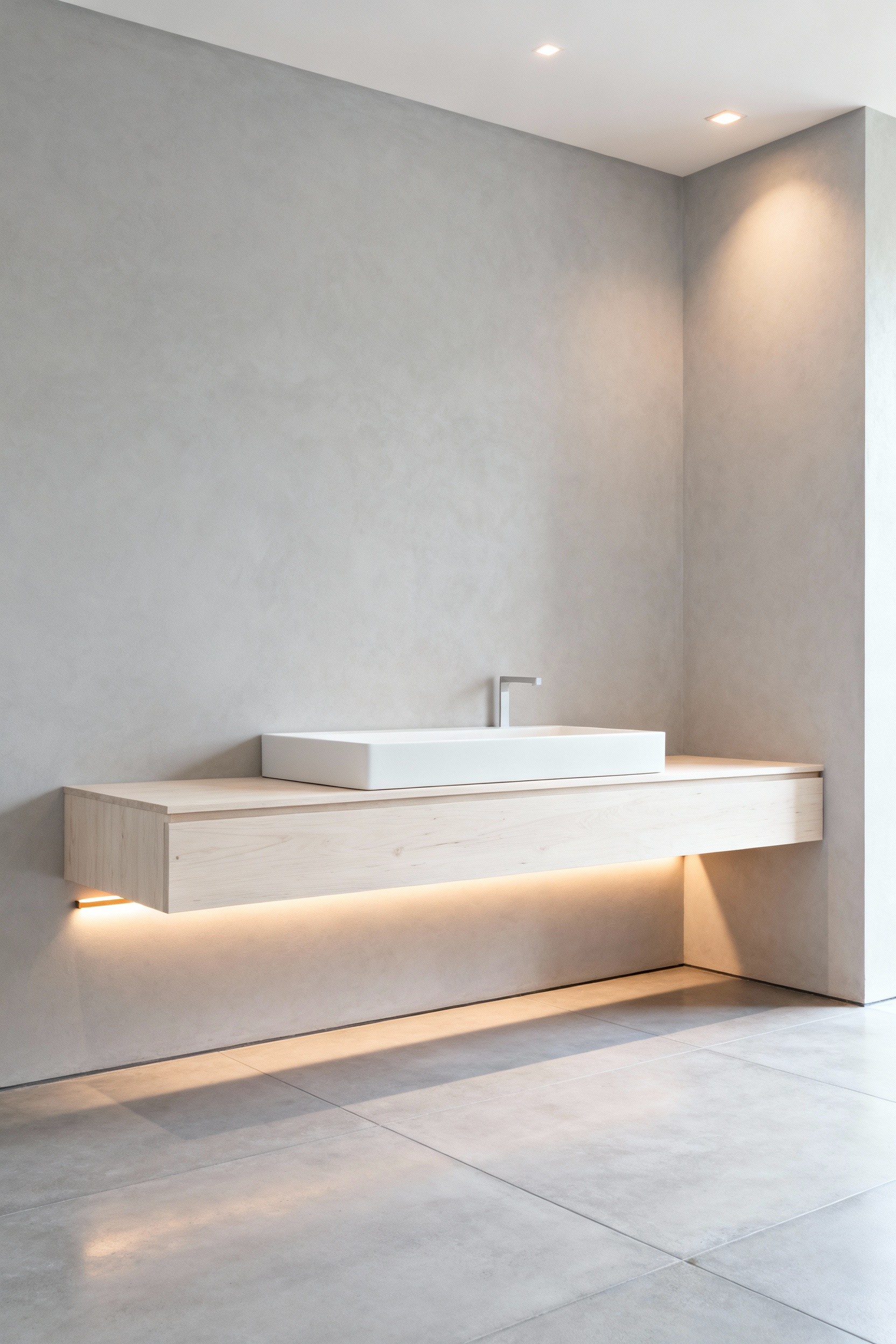
To reclaim precious square footage, we must view waste management not as furniture, but as integrated utility. Recessed in-wall systems offer the most profound impact, utilizing the wall cavity to achieve a true zero-footprint accessory. When outfitted with a tileable front or a flush stainless steel frame, the bin retreats entirely from the room’s positive space, becoming invisible until required. For renovations where recession isn’t structurally feasible, slimline wall-mounted options lift the function off the floor, preserving the continuous sweep of the tiling and eliminating the “cleaning dance” required around floor-bound obstacles.
Maintaining this unbroken visual line fosters a sense of sculptural cohesion that makes compact rooms feel expansive rather than confining. Need more stunning wall decor ideas? The tactile experience of push-to-open mechanics and the precision of concealed fixtures elevate a mundane necessity into a seamless architectural element, proving that in wellness-focused design, the most luxurious features are often the ones you don’t see.
11. Minimalist Brass Towel Warmers: The intersection of thermal comfort and sculpture
In the context of wellness architecture, the goal is often to reduce visual noise, yet standard bathroom fixtures frequently add clutter. Minimalist brass towel warmers challenge this by stripping away the “appliance” aesthetic, transforming a utilitarian object into functional sculpture. When left bare, these asymmetrical ladders or simple, elongated bars act as abstract line art against the tile. It is a deliberate architectural move, using geometry to create a sophisticated focal point that reflects light and warms the visual landscape.

The choice of material deepens this connection to the environment. Unlike the sterile, static perfection of polished chrome, unlacquered brass offers a “living finish.” Over time, exposure to air and touch allows the metal to oxidize, developing a unique patina of honey and deep bronze hues. This shift from soulless perfection to authentic depth records a tactile story of the home, grounding us in a space that feels lived-in rather than manufactured.
This material selection is also rooted in superior thermal engineering. Brass boasts a thermal conductivity of approximately 109 W/m·K, significantly outperforming the stainless steel found in lower-cost alternatives. Practically, this means heat transfers to the textile faster and more evenly. The result is a consistent, enveloping warmth that lingers, triggering the physiological relaxation response we seek in restorative spaces. It is a rare instance where the most beautiful option is also the most scientifically sound.
12. Modular Drawer Organizers: The mental clarity of ‘A Place for Everything’
The state of your bathroom drawers often mirrors the state of your mind during the morning rush. When you open a vanity to find a jumble of half-used products and tangled cords, your brain is forced to process unnecessary visual noise. Research indicates that this clutter creates a micro-moment of stress—linked to elevated cortisol levels—before your day even properly begins.
Modular organizers act as a buffer against this cognitive burden, transforming a chaotic search into a serene visual scan. By using clear acrylic or open-top trays, you eliminate the anxiety of rummaging, replacing it with the calm efficiency of instant identification.

Unlike static storage solutions, modular systems offer an engineering solution based on adaptability. These interlocking squares and rectangles allow you to create a custom grid that hugs the specific dimensions of your drawer, whether you’re working with a narrow vintage vanity or deep modern cabinetry. Whether you choose durable BPA-free plastic for resilience against spills or bamboo to introduce organic warmth, the goal is a system that evolves with you. As your skincare routine changes, the configuration can shift, ensuring the system remains a long-term architectural asset rather than a temporary fix.
Ultimately, these compartments do more than hold items; they cue behavior. Assigning a specific silhouette to every category—floss in a small square, serums in a long rectangle—makes maintaining order a subconscious reflex rather than a chore. This approach provides a tangible sense of control in an otherwise unpredictable world. It also simplifies inventory management; when a compartment is empty, you know immediately to restock, preventing the frustration of running out of essentials. In this way, a divided drawer becomes a physical anchor for mental clarity.
Section 4: Atmospheric Regulation (Light and Scent)
We need to stop viewing the bathroom merely as a utility and start treating it as an atmospheric regulator. Through the intentional layering of light and scent, this space becomes a tool for biological entrainment, guiding your body through its natural circadian rhythm rather than disrupting it.
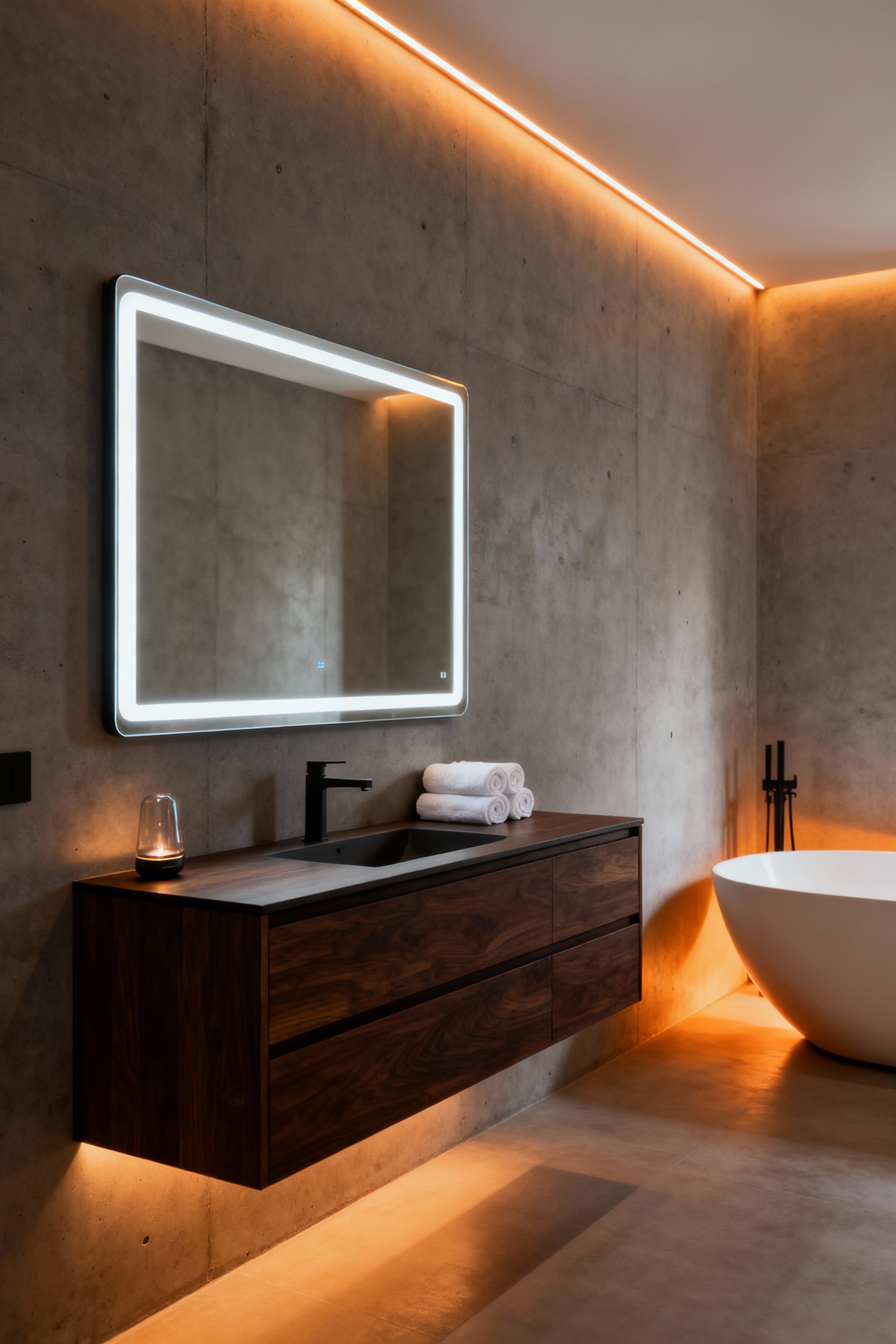
Lighting is the most potent signal for your internal clock. Beyond simple visibility, advanced LED systems and smart mirrors now offer tunable white technology that mimics the sun’s arc. In the morning, your vanity should act as a “cortisol catalyst,” utilizing a bright, cool-white spectrum between 5000K and 6500K to stimulate alertness.
Conversely, as you wind down, the space must shift to a warm, amber glow around 1800K to 2700K. This reduction in blue light preserves melatonin production, a critical step often missed in brightly tiled bathrooms. Motion-activated low-level lighting is particularly effective here, allowing for late-night navigation without jarring your system awake.
While light manages energy, scent modulates mood. We have moved far beyond the historical use of heavy perfumes to mask poor sanitation; today, fragrance is a form of “olactive art.” To maintain purity in a high-humidity environment, cold air diffusers are superior to heat-based plugins or candles. This waterless technology breaks oils into a dry mist, ensuring the scent remains refined rather than cloying. Pair crisp eucalyptus or bergamot with your morning cool-light routine to clear the mind, and switch to delicate white tea or lavender to complement the evening’s warmer tones for a true sense of retreat.
13. Circadian-Friendly Smart Bulbs: Adjusting kelvin temperatures for sleep hygiene
Think of your bathroom not just as a functional utility space, but as a primary regulator of your internal clock. Because this is often the first room we visit upon waking and the last before sleeping, the lighting quality here dictates the rhythm of our day. The science hinges on melanopsin, a photoreceptor in our eyes that is highly sensitive to the blue wavelengths found in standard “daylight” bulbs. When exposed to this cool, crisp light, your brain receives a signal to suppress melatonin—a reaction that is vital for 7:00 AM alertness but disastrous for sleep hygiene at 11:00 PM.
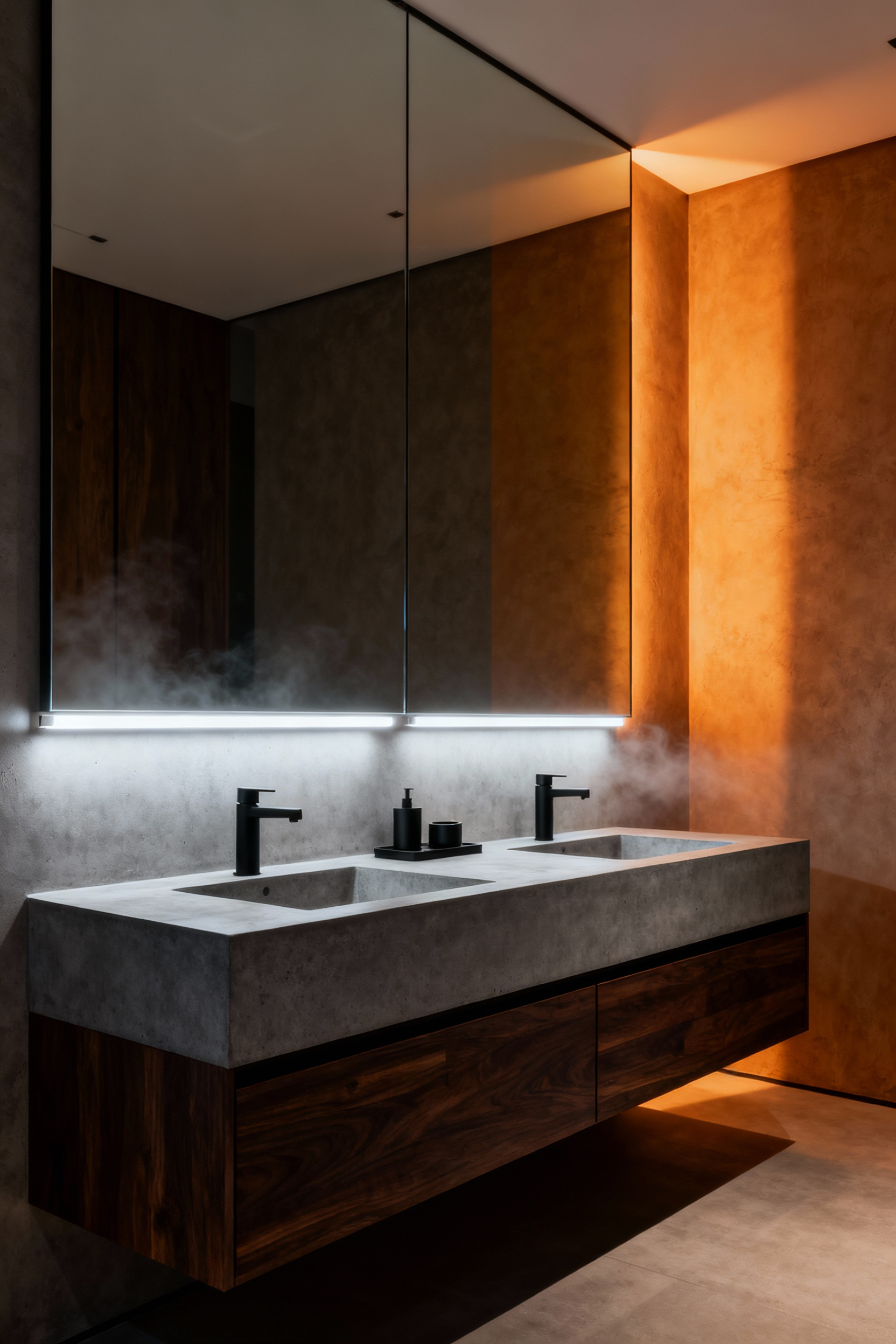
Smart bulbs resolve this biological conflict by mimicking the sun’s natural arc through tunable white light. For your morning regime, a setting between 4000K and 6000K provides the high-contrast visibility needed for grooming tasks while signaling your body to wake up. However, as the evening winds down, your environment should shift to support rest. Transitioning your fixtures to a warm, amber hue between 2200K and 3000K effectively mimics the golden light of a sunset, allowing melatonin production to begin unimpeded.
Perhaps the most critical wellness application is the “midnight safety” setting. Stumbling into a brightly lit bathroom at 2:00 AM usually causes an abrupt biological jolt, making it difficult to fall back asleep. By programming bulbs to a “campfire” glow below 2000K combined with very low dimming intensity—technically reducing the Melanopic Equivalent Daylight Illuminance (M-EDI)—you can navigate the space safely without triggering your wake-up response. It represents a modern, data-backed evolution of ancient chromotherapy, using the light spectrum to harmonize the body’s energy rather than disrupt it.
14. Ultrasonic Stone Diffusers: Safe, heat-free scent dispersal for mood regulation
True wellness architecture considers how an object influences both the visual environment and physiological health. The ultrasonic stone diffuser excels at both, moving beyond the utility of a standard gadget to function as a piece of deliberate, sculptural decor. Crafted from high-quality matte ceramic or porcelain—often utilizing natural mineral clays like kaolin—these devices resemble handmade pottery. This organic texture allows them to blend seamlessly into a luxury bathroom, complementing materials like granite or warm wood rather than disrupting them with industrial plastic.

Beneath this sophisticated exterior lies a mechanism designed to preserve the therapeutic integrity of your essential oils. Unlike traditional burners that rely on heat, which can degrade delicate chemical compounds, these diffusers use a small internal disk vibrating at millions of cycles per second. This breaks water and oil into a microscopic, cool mist. By utilizing cold diffusion, the device ensures that the holistic properties of the oil—whether the anti-anxiety effects of lavender or the stimulating power of eucalyptus—remain chemically unaltered and potent.
This safety-conscious design, featuring automatic shut-off capabilities, makes it an ideal “set-and-forget” tool for curating your daily rituals. You might program the device to disperse invigorating sweet orange or lime during your morning shower to sharpen focus, then switch to grounding ylang-ylang in the evening to prepare the body for sleep. The plume of cool mist also serves as a subtle humidifier, combating the drying effects of indoor air while transforming the bathroom into a responsive, sensory sanctuary.
15. Non-Toxic Beeswax Candles: Purifying the air while creating ritualistic lighting
In the intimate, often unventilated space of a bathroom, what you burn matters as much as what you apply to your skin. While standard paraffin candles often release volatile organic compounds (VOCs) like benzene, effectively polluting your sanctuary with petroleum byproducts, beeswax offers a restorative alternative. It burns cleanly and slowly, producing virtually no soot, which is critical for maintaining healthy indoor air quality in smaller rooms.
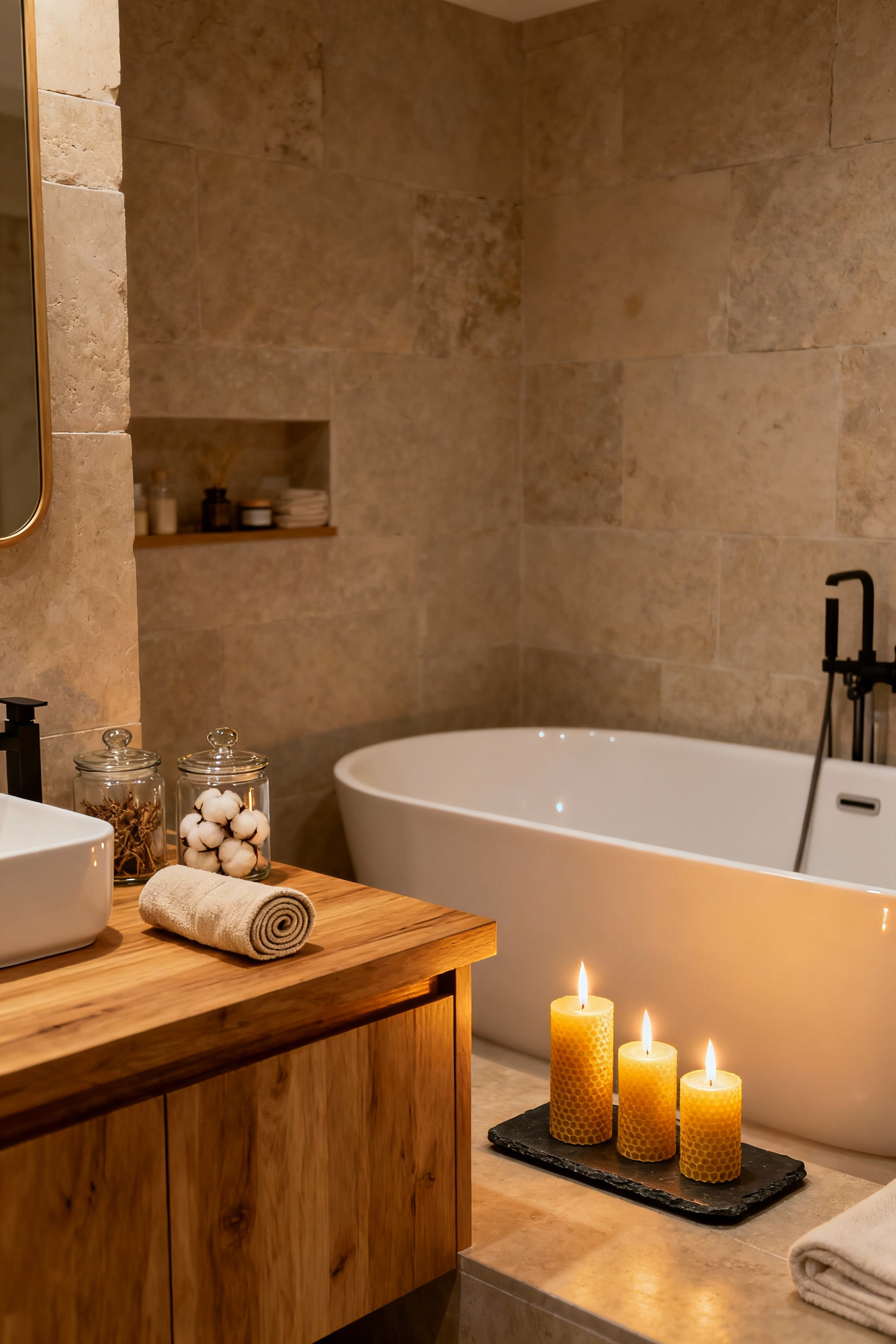
Beyond simply avoiding toxins, beeswax creates an active wellness environment. When lit, these candles are believed to release negative ions—nature’s method for neutralizing airborne pollutants like dust and mold spores. While the scale of this purification is often debated, the visual benefits are indisputable. Beeswax emits a flame within the same light spectrum as the sun. This warm, golden glow is far superior to harsh artificial lighting for signaling your nervous system to wind down, making it an essential tool for evening rituals and preparing the body for sleep.
There is a reason this material was historically reserved for royalty and sacred spaces; its purity sets a tone of reverence. Unlike the cloying, synthetic fragrances that can trigger headaches or respiratory sensitivities, pure beeswax carries only the subtle, sweet aroma of honey and wildflowers directly from the hive. Lighting one becomes a deliberate act of self-care, transforming a routine bath into a meditative retreat and ensuring the air remains as clean as the light is calming.
Section 5: The Tools of Ritual
To truly transform a bathroom into a sanctuary, we must view accessories not as mere decorations, but as the active tools of a ritual. There is a profound psychological shift that occurs when you engage with objects that possess distinct material weight. Replacing a disposable plastic container with a dispenser made of solid brass, hand-polished marble, or matte stone introduces a tactile permanence to the environment. The intrinsic weight and cool touch of these materials anchor you in the present moment, forcing a pause that turns a mindless routine into a deliberate practice.

This approach revives the wisdom of ancient wellness traditions, such as the Roman *thermae* or the Turkish *hammam*. In these spaces, bathing was never just about hygiene; it was a structured progression of physical and spiritual renewal aided by specific implements. Today, our modern equivalents—whether a teak bath caddy or a stack of plush Egyptian cotton towels—serve the same purpose. They are physical cues that signal a departure from the noise of the outside world and an entry into a space of restoration.
How we organize these tools is just as critical as the materials themselves. A cluttered surface creates a cluttered mind, inhibiting the relaxation response. Using elegant trays made of stone or wood serves as an anchoring device, corralling items like skincare or scents into a single, curated vignette. By establishing this visual order and ensuring a cohesive design language across your accessories, you remove visual friction. This intentionality allows the architecture of the room to support your mental wellbeing, making the act of self-care feel effortless rather than chaotic.
16. Natural Bristle Dry Brushes: Accessories for lymphatic health
Integrating a natural bristle dry brush into your bathroom setup does more than add a textural, organic element to your vanity; it anchors your daily routine in a practice with centuries of precedence. From Ayurvedic Garshana to Roman bathing rituals, the act of stimulating the skin has long been recognized as vital for vitality. Unlike the circulatory system, your lymphatic system—responsible for immune health and waste removal—lacks a central pump. It relies on movement and external pressure to function efficiently.

This is where the accessory transforms into a legitimate wellness tool. Using long, sweeping strokes always directed toward the heart, the brush manually assists the flow of lymph fluid. While the concept of systemic “detoxification” is often debated, the immediate benefits of enhanced capillary microcirculation are undeniable. The friction of natural bristles against dry skin acts as a potent neuro-sensory stimulant, leaving the skin with a healthy, rosy glow and the mind feeling surprisingly alert—often described as a wake-up massage that rivals caffeine.
Selecting the right texture is essential for customizing this ritual to your body’s needs. For a vigorous, deep exfoliation often preferred for legs and thighs, look for firm plant-based fibers like agave cactus (Tampico). If you have sensitive skin or are focusing on the chest and arms, softer options like boar hair provide gentle stimulation without abrasion. Beyond the physical benefits, the rhythmic repetition offers a moment of mindfulness, turning a simple pre-shower step into an invigorating reset for the nervous system.
17. Hand-Thrown Ceramic Vessels: Embracing wabi-sabi and the beauty of imperfection
Most bathrooms are defined by sterile perfection—smooth porcelain, rigid tiles, and flawless chrome. Introducing a hand-thrown ceramic vessel disrupts this cold uniformity with the Japanese philosophy of Wabi-Sabi. This aesthetic roots itself in Zen Buddhism, finding profound beauty in the modest, the weathered, and the impermanent. Placing a raw, earthen vessel on your vanity does more than hold cotton swabs; it acts as a micro-moment of mindfulness, inviting you to pause and appreciate the natural simplicity that contrasts the mass-produced world.
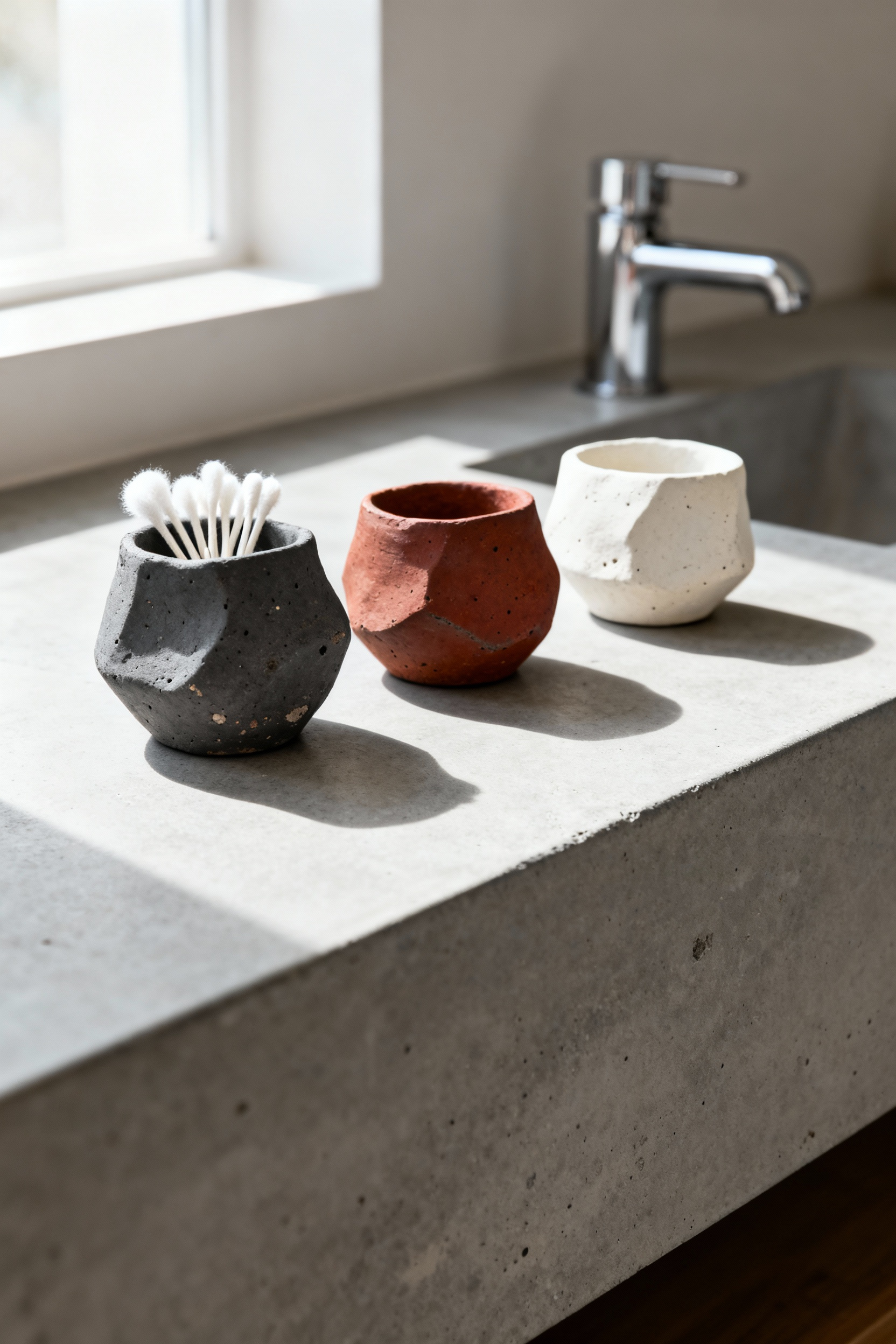
True wellness design engages the senses, and these vessels offer necessary tactile grounding. Look for pieces that exhibit *Fukinsei*, or intentional asymmetry. A slightly wobbly rim or visible ridges left by a potter’s fingers act as a permanent record of the human hand, celebrating the flow of creation over industrial precision. Rough, unglazed surfaces or the unpredictable drips of natural ash glazing provide a sensory counterpoint to the slick, glossy surfaces typical of modern fixtures, reconnecting the user to organic materials.
Choosing these pieces also shifts your mindset from disposability to resilience. The tradition embraces damage through *Kintsugi*—the art of repairing cracks with gold to highlight rather than hide the history of the object. Even without gold repair, selecting accessories meant to weather and patina teaches us that age adds character. These vessels become small emblems of resilience, transforming a daily hygiene routine into a connection with the perfectly imperfect nature of life.
Conclusion: Curating a space that cares for you in return
View your bathroom accessories not merely as finishing touches, but as active participants in your daily well-being. When we select fixtures with intention—treating a faucet as a ritual tool or a stone tray as a sensory anchor—we transform a utilitarian room into a restorative sanctuary. This shift towards tactile richness and “soft minimalism” allows the space to communicate care through every touchpoint. By prioritizing durable materials and clever storage that proactively reduces visual noise, you are designing a support system that tends to your mental clarity just as much as your physical hygiene.
The truest form of luxury is a distinct lack of friction, achieved through intentional bathroom accessories ideas that offer permanence without demanding constant maintenance. Begin by auditing your current vanity with this lens: remove items that feel transient or cluttered, and invest in fewer, higher-quality pieces that offer a sense of weight and warmth. In doing so, you ensure your private retreat remains a source of enduring calm, supporting your best self every single day.
Frequently Asked Questions (FAQ)
What accessories make a bathroom look luxurious?
Luxury in bathroom accessories is defined by material quality and intentional design rather than volume. Focus on weighted materials that offer tactile grounding, such as solid unlacquered brass, honed marble, or hand-thrown ceramics. Replace plastic containers with uniform, refillable glass dispensers (amber or frosted). High-end textiles, like organic waffle-weave linen towels and thick bath mats made of Diatomaceous Earth, also significantly elevate the perceived quality of the space.
How do I organize bathroom accessories stylishly to reduce visual clutter?
The goal is “visual silence.” Achieve this by decanting all liquid products into matching, logo-free vessels to eliminate brand noise. Utilize modular drawer organizers to keep functional clutter hidden within vanities, maintaining completely clear countertops. Use anchoring trays made of natural stone (like travertine or slate) to corral visible essentials into curated vignettes, transforming multiple items into a single, organized unit.
What is the best color palette for creating a spa-like feel with bathroom accessories?
A spa-like atmosphere relies on a calming, neutral palette that supports the nervous system. Stick to earthy, desaturated tones: matte white, soft pale gray, bone white, deep charcoal, and warm biscuit tones (found in natural wood or travertine). If introducing color, use natural, organic hues like deep forest green (for plants/eucalyptus) or subtle amber (for glass dispensers), ensuring the colors act as textural accents rather than distracting focal points.
